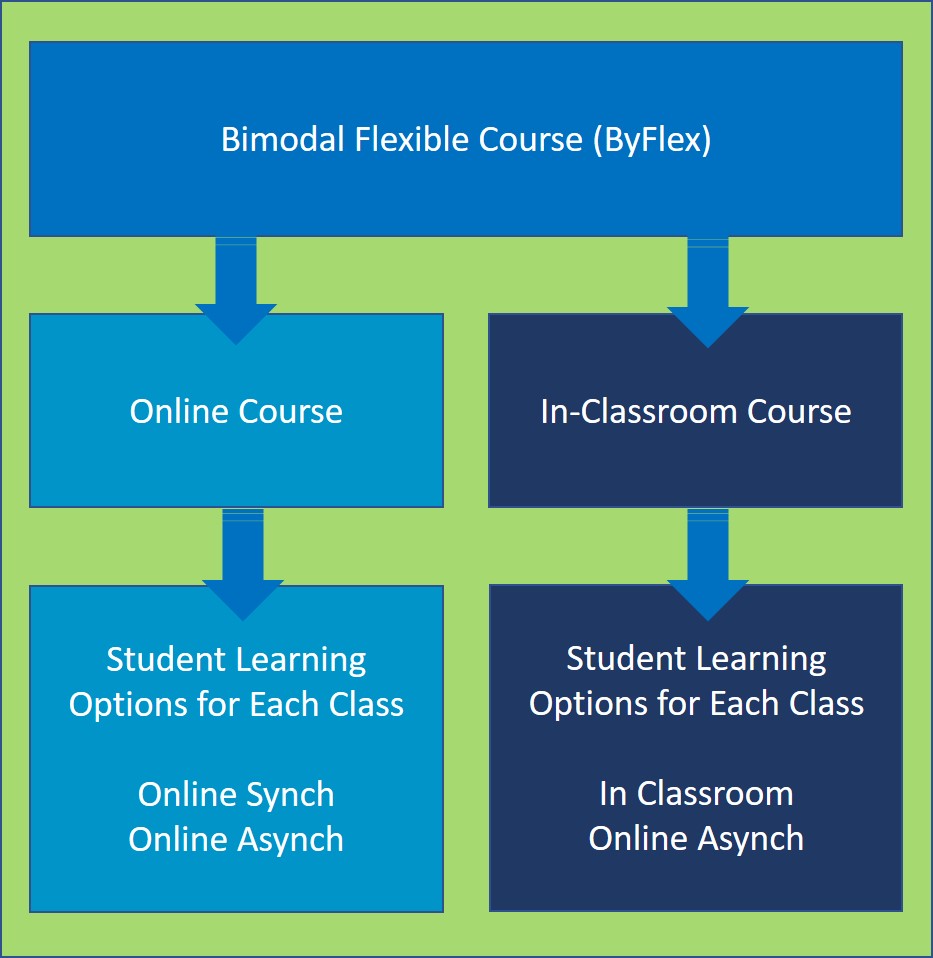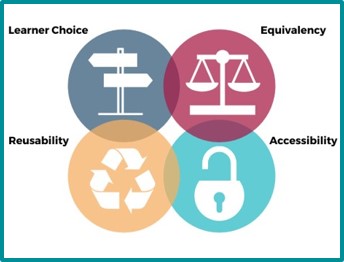Chapter 1: What are Bimodal Flexible Courses?
What is Flexible Course Design?
Many colleges and universities had to quickly develop online courses for delivery during the COVID pandemic in order to maintain operations and continue to serve students. As students returned to classes on campus, institutions recognized that there was still a need to provide students with flexible options for how they attend and participate in courses. Flexible courses allow students to customize a school-work-life balance that supports their specific situation and needs.
Many of us have experienced online courses or on-campus courses over the years. Some of us have experienced hybrid (or blended) courses wherein part of the course may have been offered online while other parts were offered in the classroom. Few of us have probably experienced a truly flexible course, such as a trimodal or a bimodal course. In these types of courses, students have choices for every class session whether to attend in person or participate online (either synchronously or asynchronously).
Flexible courses enhance inclusivity by building student-centered, self-directed learning, and empowering students to choose how and when they learn. Flexible courses align with the practice of Universal Design for Learning (UDL)–“The primary focus is on finding ways to teach the material to the many types of learners in a classroom. Teachers plan lessons to address a wide range of needs and strengths. There’s no “typical” student.”[1] When flexible courses are designed, developed, and delivered well they can reduce barriers to participation. Flexible options support the needs of marginalized learners but also benefit all learners.
What is the Bimodal Flexible (ByFlex) Course Model?
The term bimodal means two modes, and in flexible course design, it means two delivery modes that are offered within the same course. As educational institutions continue to review flexible course delivery it may become evident that the bimodal flexible course model is one of the course models that can support students’ needs as well as institutional goals.

Some institutions, such as Concordia University define a bimodal course as “Everyone participates in a single synchronous (live) class session: the professor and a portion of students participate in person while the remainder of students participate remotely. This is what is referred to as a bimodal classroom because it allows faculty to make teaching and learning possible by combining two groups of learners. Students can attend class in-person when on campus, or they can attend virtually online via Zoom when located remotely.”[2]
The University of Ottawa agrees with Concordia University in its definition of a bimodal course. “This approach is a combination of two distinct, real-time (synchronous) teaching spaces. The first is a physical space (in a classroom on campus) with an instructor present and a reduced number of students. The second is a virtual space using a web conferencing technology (Zoom or MS Teams) with students who choose to take the course remotely.”[3]
In these two examples (above), the type of bimodal model being used allows students a choice between two modes of synchronous learning for each session over the duration of the course. While this does provide flexibility for students who prefer (or need to) to stay home to learn, it does not allow flexibility in meeting times as students must meet with the professor as the classes are scheduled by the institution. This can be an issue for some students, such as those who live in a different time zone, have small children at home, or have a full-time career. This model for bimodal flexible course design may not be flexible enough to meet students’ needs.
Does it seem a bit limited in flexibility to only offer students a choice between two synchronous delivery modes? Would a bimodal course design not provide more flexibility if it offered an option between synchronous or asynchronous attendance and participation? What if it also allowed students to vary their choice each week, for each class? That might be rather flexible, don’t you agree?
Currently, there has been little research done in the area of flexible courses that combine one synchronous and one asynchronous component in a single course, although, the following article does discuss blending these options within an online course. There does not appear to be any mention of a bimodal course that combines an on-campus synchronous delivery with an online asynchronous option. “While research into and adoption of online learning has increased, this article explores a particular aspect of online learning—the blending of synchronous and asynchronous online learning into what we label bichronous online learning. We contend that the blend of synchronous and asynchronous online learning potentially reduces some of the challenges of asynchronous online learning alone, including a lack of immediacy, community, interaction, and audiovisual communication.[4]
Refer to Table 1.1 for the definition of synchronous and asynchronous.
| Synchronous Online | Synchronous In-Classroom | Asynchronous |
|---|---|---|
| Students and their educator(s) are online at the same time. | Students and their educator(s) are in a classroom or lab on campus. | Students are online, but not at a specific time. Educators are not online at the same time as students. |
| Typically uses a virtual classroom/chat room. May use an online conferencing tool such as Zoom or Teams. May or may not use cameras and audio. No need to commute. | Face-to-face delivery and interactions, discussions, etc. take place. May use a screen and projector to share information. | Students set their own pace for learning (within deadlines) and take control of their learning. They can prioritize what they learn. No need to commute. |
| Immediate feedback. | Immediate feedback. | Feedback is not in real-time, not immediate. |
| Can be less isolating than asynchronous for students. The educator helps motivate students and guides and directs them on what needs to be accomplished by due dates. | Not isolating because of the face-to-face experience. The educator helps motivate students and guides and directs them on what needs to be accomplished by due dates. | Can be isolating for students. Students need to be self-motivated and disciplined enough to keep up with the course activities and due dates. |
| Students choose WHERE but not WHEN to learn. | Students do NOT choose WHERE or WHEN to learn. | Students choose WHERE and WHEN to learn. |
Definition: Bimodal Flexible (ByFlex) Course Model
A Bimodal flexible (ByFlex) course model offers students two options for attending and participating in courses, online or on campus. Then, offers two options again, synchronously or asynchronously. It provides students with flexibility in how they prefer to attend and participate in courses from session to session throughout the course duration. This allows students to customize a school-work-life balance that works for their specific situation and needs. The two ByFlex options are listed below and also depicted in Figure 1.1 below.
- Each student chooses for each course class session to either learn on campus (in person) at the time the course is scheduled, at the same time as the educator, OR to learn online asynchronously at a time the student prefers.
- Each student chooses for each course class session to either learn online synchronously at the time the course is scheduled, at the same time as the educator, OR to learn online asynchronously at a time the student prefers.

To make bimodal courses more flexible, the two modes offered for learning should be synchronous and asynchronous, with a choice for students for each class session. When flexible courses are designed for two different groups of learners (synchronous and asynchronous) supportive learning materials and resources must be created for both groups. “Blending synchronous and asynchronous allows us to gain the unique benefits from each modality while overcoming the unique limitations”.[5] Students who are living in different time zones, who may be ill, who may have to go to work, or who may have small children at home might prefer to attend the course asynchronously. This does, however, involve more planning and designing within the course learning management system (LMS) because course learning materials, resources, and weekly flow of content need to be available, clear, and directive so that students can self-direct through the LMS learning modules and meet the course learning objectives. It provides students with self-paced learning while adhering to the course schedule and deadlines.
What are the Four Principles for HyFlex Course Design?

Brian J. Beatty established four principles for HyFlex course design which include Learner Choice, Equivalency, Reusability, and Accessibility.[6] These principles can be applied similarly to ByFlex course design.
- Learner Choice: Provide meaningful alternative participation modes and enable students to choose between participation modes daily, weekly, or topically.
- Equivalency: Provide learning activities in all participation modes which lead to equivalent learning outcomes.
- Reusability: Utilize artifacts from learning activities in each participation mode as “learning objects’ for all students.
- Accessibility: Equip students with technology skills and equitable access to all participation modes.
What are the Advantages of the ByFlex Course Model?
What’s great about the ByFlex course model is that it takes what institutions already offer, courses online or courses on campus, and adds an asynchronous option for student attendance and participation. Bimodal (ByFlex) courses offer more flexibility to students than traditional courses do, but not quite as much flexibility as trimodal (HyFlex) courses. ByFlex course design provides the flexibility students need, while HyFlex course design may be providing more than students need or will utilize, at a higher cost, with few additional benefits in comparison to ByFlex. ByFlex may not have as many challenges as HyFlex because it removes the dual delivery of two synchronous groups of learners at the same time. Due to some of the inherent challenges with HyFlex, many colleges and universities only offer one or two courses within a program in HyFlex delivery mode, the remaining courses are offered in less flexible delivery modes (i.e., online, in-classroom, hybrid/blended).
Additional Resources
- Explaining the difference between Hybrid and HyFlex Teaching Models
- What’s the Difference Between Asynchronous and Synchronous Learning?
- Blended Learning vs Flexible Learning – What’s The Difference?
- Flipping the Classroom Script: Flipped Learning vs. Traditional Classroom Learning
- The difference between Universal Design for Learning (UDL) and traditional education
- Online Classes vs Traditional Classes – What’s The Difference?
- Distance Learning vs Traditional Learning – Pros and Cons
- Why HyFlex Course Delivery Doesn’t Always Work
- Bichronous Online Learning: Blending Asynchronous with Synchronous Learning
References
(Note: This list of sources used is NOT in APA citation style instead the auto-footnote and media citation features of Pressbooks were utilized to cite references throughout the chapter and generate a list at the end of the chapter.)
Media Attributions
- ch1student © Budgeron Bach is licensed under a CC0 (Creative Commons Zero) license
- ByFlex © Kerri Shields is licensed under a CC BY-NC-SA (Attribution NonCommercial ShareAlike) license
- Beatty4values © Cambrian College is licensed under a CC BY-NC-SA (Attribution NonCommercial ShareAlike) license
- The Understood Team. (n.d.). The difference between Universal Design for Learning (UDL) and traditional education. https://www.understood.org/en/articles/the-difference-between-universal-design-for-learning-udl-and-traditional-education ↵
- Concordia University. (n.d.). Center for teaching and learning: Bimodal classrooms. https://www.concordia.ca/ctl/teaching/bimodal-classrooms.html ↵
- Ottawa University. (2020-2021). Bimodal approach at Ottawa University. https://saea-tlss.uottawa.ca/en/course-design/bimodal-teaching#:~:text=This%20approach%20is%20a%20combination%20of%20two%20distinct%2C,students%20who%20choose%20to%20take%20the%20course%20remotely. ↵
- Martin, f., Polly, D., Ritzhaupt, A. (2020, September 8). Bichronous online learning: Blending asynchronous and synchronous online learning. Educause. https://er.educause.edu/articles/2020/9/bichronous-online-learning-blending-asynchronous-and-synchronous-online-learning ↵
- Shank, P. (2020, July 24). (The right) learning modalities to deliver digital learning: Part 5. https://elearningindustry.com/blending-asynchronous-and-synchronous-digital-learning-modalities-part-5 ↵
- Beatty, B. (2019). Hybrid-flexible course design. (ch 1.3) https://edtechbooks.org/hyflex/hyflex_values ↵

